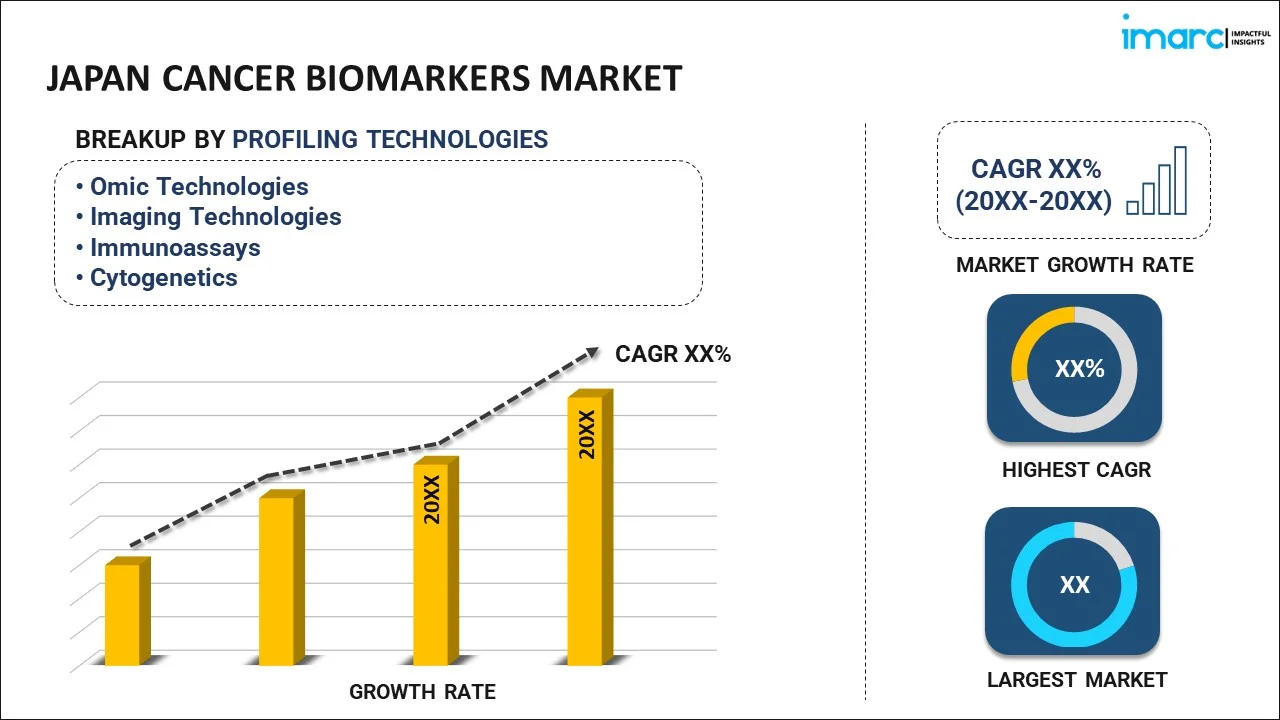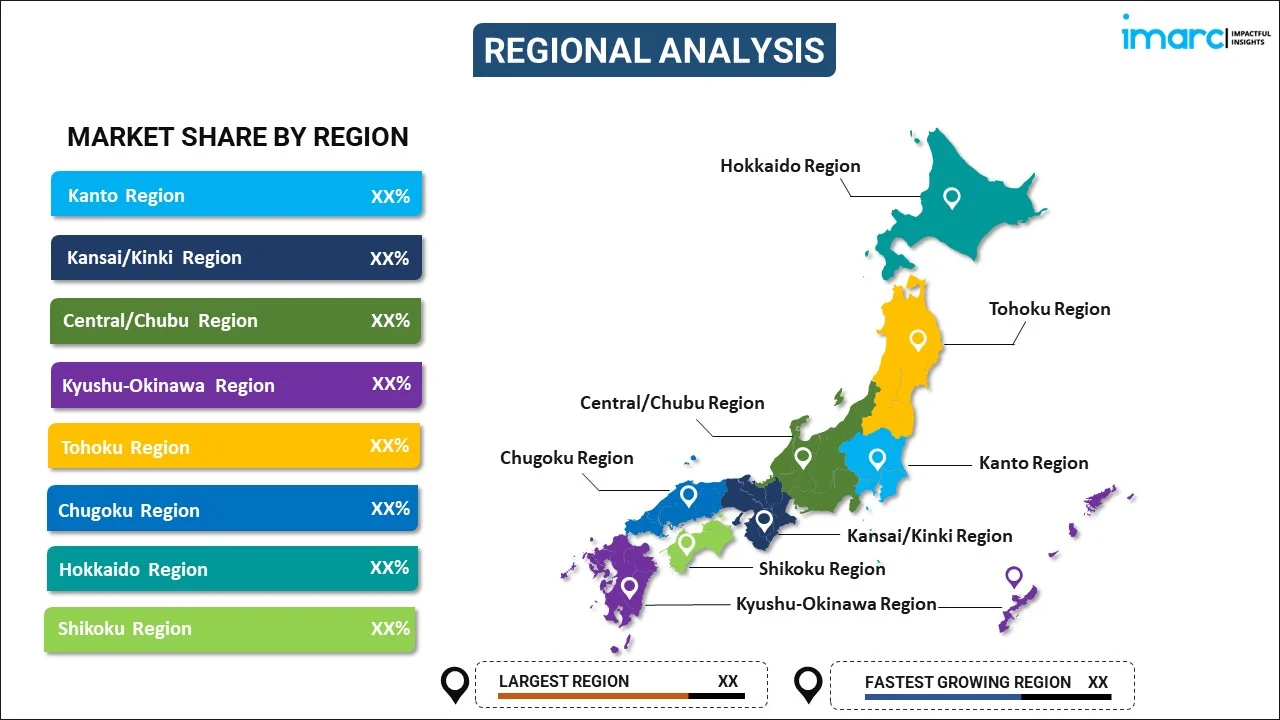
Japan Cancer Biomarkers Market Report by Profiling Technology (Omic Technologies, Imaging Technologies, Immunoassays, Cytogenetics), Biomolecule (Genetic Biomarkers, Protein Biomarkers, Glyco-Biomarkers), Cancer Type (Breast Cancer, Lung Cancer, Colorectal Cancer, Prostate Cancer, Stomach Cancer, and Others), Application (Diagnostics, Prognostics, Risk Assessment, Drug Discovery and Development, and Others), End User (Hospitals, Academic and Research Institutions, Ambulatory Surgical Centers, Diagnostic Laboratories, and Others), and Region 2025-2033
Market Overview:
Japan cancer biomarkers market size reached USD 1,252.6 Million in 2024. Looking forward, IMARC Group expects the market to reach USD 3,621.3 Million by 2033, exhibiting a growth rate (CAGR) of 11.2% during 2025-2033. The increasing cases of cancer, coupled with the rising need for effective diagnostic and monitoring tools to significantly improve the chances of successful treatment and better patient outcomes, are driving the market.
|
Report Attribute
|
Key Statistics
|
|---|---|
|
Base Year
|
2024 |
|
Forecast Years
|
2025-2033 |
|
Historical Years
|
2019-2024
|
| Market Size in 2024 | USD 1,252.6 Million |
| Market Forecast in 2033 | USD 3,621.3 Million |
| Market Growth Rate (2025-2033) | 11.2% |
Cancer biomarkers are molecules or substances found in the body that can indicate the presence of cancer or provide information about its characteristics. These biomarkers are typically detected through blood tests, tissue samples, or imaging studies. They play a crucial role in cancer diagnosis, prognosis, and treatment. Biomarkers can include proteins, genes, hormones, or even specific cellular changes. By analyzing their levels or activity, healthcare professionals can identify the type of cancer, its stage, and its potential aggressiveness. This information helps in tailoring treatment plans, monitoring disease progression, and assessing treatment effectiveness. Cancer biomarkers also have a significant impact on personalized medicine, enabling doctors to choose the most appropriate therapies for individual patients. Additionally, they aid in cancer research, facilitating the development of new drugs and therapies. Overall, cancer biomarkers are essential tools in the fight against cancer, contributing to early detection, precise treatment, and improved patient outcomes.
Japan Cancer Biomarkers Market Trends:
The cancer biomarkers market in Japan is driven by several key factors that collectively contribute to its growth and significance in the field of oncology. Firstly, advancements in molecular biology and genomics have paved the way for the identification of novel biomarkers that can aid in early cancer detection and prognosis. Moreover, the increasing prevalence of cancer in Japan is a major driver, as there is a growing need for accurate and efficient diagnostic tools to combat this regional health challenge. Furthermore, the development of targeted therapies and personalized medicine approaches has accentuated the demand for biomarkers. These biomarkers assist in tailoring treatment plans to individual patients, improving the overall efficacy of cancer treatments while minimizing adverse effects. Additionally, the rise in R&D activities in the pharmaceutical and biotechnology sectors has spurred investments in biomarker discovery and validation, further propelling market growth. Moreover, the widespread adoption of liquid biopsy techniques for non-invasive biomarker detection, as they offer a less invasive alternative to traditional tissue biopsies, is expected to drive the cancer biomarkers market in Japan during the forecast period.
Japan Cancer Biomarkers Market Segmentation:
IMARC Group provides an analysis of the key trends in each segment of the market, along with forecasts at the country level for 2025-2033. Our report has categorized the market based on profiling technology, biomolecule, cancer type, application, and end user.
Profiling Technology Insights:

- Omic Technologies
- Imaging Technologies
- Immunoassays
- Cytogenetics
The report has provided a detailed breakup and analysis of the market based on the profiling technology. This includes omic technologies, imaging technologies, immunoassays, and cytogenetics.
Biomolecule Insights:
- Genetic Biomarkers
- Protein Biomarkers
- Glyco-Biomarkers
A detailed breakup and analysis of the market based on the biomolecule have also been provided in the report. This includes genetic biomarkers, protein biomarkers, and glyco-biomarkers.
Cancer Type Insights:
- Breast Cancer
- Lung Cancer
- Colorectal Cancer
- Prostate Cancer
- Stomach Cancer
- Others
The report has provided a detailed breakup and analysis of the market based on the cancer type. This includes breast cancer, lung cancer, colorectal cancer, prostate cancer, stomach cancer, and others.
Application Insights:
- Diagnostics
- Prognostics
- Risk Assessment
- Drug Discovery and Development
- Others
A detailed breakup and analysis of the market based on the application have also been provided in the report. This includes diagnostics, prognostics, risk assessment, drug discovery and development, and others.
End User Insights:
- Hospitals
- Academic and Research Institutions
- Ambulatory Surgical Centers
- Diagnostic Laboratories
- Others
The report has provided a detailed breakup and analysis of the market based on the end user. This includes hospitals, academic and research institutions, ambulatory surgical centers, diagnostic laboratories, and others.
Regional Insights:

- Kanto Region
- Kansai/Kinki Region
- Central/ Chubu Region
- Kyushu-Okinawa Region
- Tohoku Region
- Chugoku Region
- Hokkaido Region
- Shikoku Region
The report has also provided a comprehensive analysis of all the major regional markets, which include Kanto Region, Kansai/Kinki Region, Central/ Chubu Region, Kyushu-Okinawa Region, Tohoku Region, Chugoku Region, Hokkaido Region, and Shikoku Region.
Competitive Landscape:
The market research report has also provided a comprehensive analysis of the competitive landscape in the market. Competitive analysis such as market structure, key player positioning, top winning strategies, competitive dashboard, and company evaluation quadrant has been covered in the report. Also, detailed profiles of all major companies have been provided.
Japan Cancer Biomarkers Market Report Coverage:
| Report Features | Details |
|---|---|
| Base Year of the Analysis | 2024 |
| Historical Period | 2019-2024 |
| Forecast Period | 2025-2033 |
| Units | Million USD |
| Scope of the Report | Exploration of Historical and Forecast Trends, Industry Catalysts and Challenges, Segment-Wise Historical and Predictive Market Assessment:
|
| Profiling Technologies Covered | Omic Technologies, Imaging Technologies, Immunoassays, Cytogenetics |
| Biomolecules Covered | Genetic Biomarkers, Protein Biomarkers, Glyco-Biomarkers |
| Cancer Types Covered | Breast Cancer, Lung Cancer, Colorectal Cancer, Prostate Cancer, Stomach Cancer, Others |
| Applications Covered | Diagnostics, Prognostics, Risk Assessment, Drug Discovery and Development, Others |
| End Users Covered | Hospitals, Academic and Research Institutions, Ambulatory Surgical Centers, Diagnostic Laboratories, Others |
| Regions Covered | Kanto Region, Kansai/Kinki Region, Central/ Chubu Region, Kyushu-Okinawa Region, Tohoku Region, Chugoku Region, Hokkaido Region, Shikoku Region |
| Customization Scope | 10% Free Customization |
| Post-Sale Analyst Support | 10-12 Weeks |
| Delivery Format | PDF and Excel through Email (We can also provide the editable version of the report in PPT/Word format on special request) |
Key Questions Answered in This Report:
- How has the Japan cancer biomarkers market performed so far and how will it perform in the coming years?
- What has been the impact of COVID-19 on the Japan cancer biomarkers market?
- What is the breakup of the Japan cancer biomarkers market on the basis of profiling technology?
- What is the breakup of the Japan cancer biomarkers market on the basis of biomolecule?
- What is the breakup of the Japan cancer biomarkers market on the basis of cancer type?
- What is the breakup of the Japan cancer biomarkers market on the basis of application?
- What is the breakup of the Japan cancer biomarkers market on the basis of end user?
- What are the various stages in the value chain of the Japan cancer biomarkers market?
- What are the key driving factors and challenges in the Japan cancer biomarkers?
- What is the structure of the Japan cancer biomarkers market and who are the key players?
- What is the degree of competition in the Japan cancer biomarkers market?
Key Benefits for Stakeholders:
- IMARC’s industry report offers a comprehensive quantitative analysis of various market segments, historical and current market trends, market forecasts, and dynamics of the Japan cancer biomarkers market from 2019-2033.
- The research report provides the latest information on the market drivers, challenges, and opportunities in the Japan cancer biomarkers market.
- Porter's five forces analysis assist stakeholders in assessing the impact of new entrants, competitive rivalry, supplier power, buyer power, and the threat of substitution. It helps stakeholders to analyze the level of competition within the Japan cancer biomarkers industry and its attractiveness.
- Competitive landscape allows stakeholders to understand their competitive environment and provides an insight into the current positions of key players in the market
Need more help?
- Speak to our experienced analysts for insights on the current market scenarios.
- Include additional segments and countries to customize the report as per your requirement.
- Gain an unparalleled competitive advantage in your domain by understanding how to utilize the report and positively impacting your operations and revenue.
- For further assistance, please connect with our analysts.
 Inquire Before Buying
Inquire Before Buying
 Speak to an Analyst
Speak to an Analyst
 Request Brochure
Request Brochure
 Request Customization
Request Customization




.webp)




.webp)












